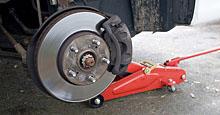
You’ve spent your summer acting as the family chauffeur, towing boats and trailers, driving to events and taking extended road trips.
How does all that driving affect the safety of your vehicle and its ability to stop?
According to the expert auto technicians, summer temperatures create extreme friction in brake components such as pads and rotors. Heat build-up can cause brake systems to respond slowly or fail completely.
That is especially true for frequent braking as you driving down steep inclines and along curvy mountain roads. Towing another vehicle also accelerates wear.
“Never delay in having your brake system inspected or repaired,” said Tony Molla, vice president of communications for the National Institute for Automotive Service Excellence.
Modern brake systems use palm-sized brake pads that press against disc-shaped rotors. The resulting friction stops the vehicle.
Molla suggested drivers listen for the high pitched squeal of old brake pads—a telltale sign they need replacing.
“If you hear grinding or metal-on-metal contact then you may need to replace the rotor,” he said. “Rotors require careful inspection of a trained technician because even slight wear can warrant their replacement, and precision tools such as micrometers are needed to measure that wear.”
As a general rule, Molla said, brakes need to be inspected anytime they start making noise.
In the past, rotors would be “resurfaced,” or sanded, to create a smooth surface for the brake pads. Modern vehicles often require replacement rather than resurfacing.
“Rotors in many modern vehicles are thin and light-weight,” Molla said. “As a result, they have become a replacement part.”
The stopping ability of your vehicle depends on critical components in the braking system. Molla offered the following suggestions:

-
Listen for scratching or squealing sounds coming from your wheels, an indication of damaged or worn brake pads or rotors. Get your vehicle inspected immediately.
-
Does your vehicle respond slowly when you push the brake pedal? Does the pedal go all the way to the floor? Both situations signal potentially serious problems with your vehicle's braking system.
-
Ask your service advisor to inspect rotors anytime you replace or rotate tires, replace brake pads or get an alignment. That saves time, and it also helps avoid brake problems such as the inability to stop your vehicle suddenly.
-
Take your vehicle in for a rotor and brake inspection anytime the brake warning light is displayed on the vehicle dashboard.
-
Don’t delay brake repair. Ignoring warning signs such as slow brake response or squealing noises could cause your brake system to fail.
-
Use only a certified technician to inspect the brake system. Brake systems in most modern vehicles are designed to replace rather than resurface rotors.
-
Inspect rotors and brake systems at least twice per year at the minimum.
“The best way to deal with brake rotors is to have the vehicle regularly inspected by a qualified technician,” “You should do that two times a year, at a minimum.”
Copyright © 2024 by Sensible Driver. All rights reserved.